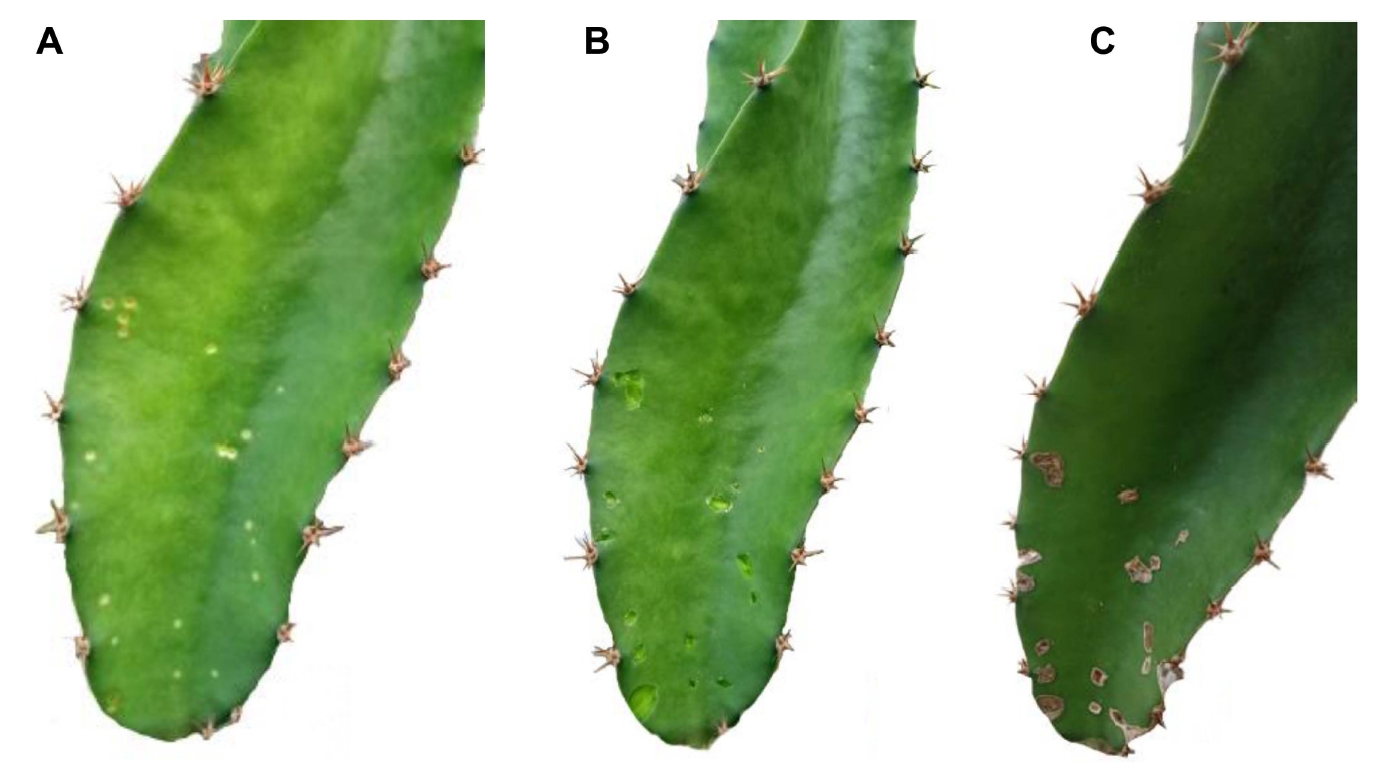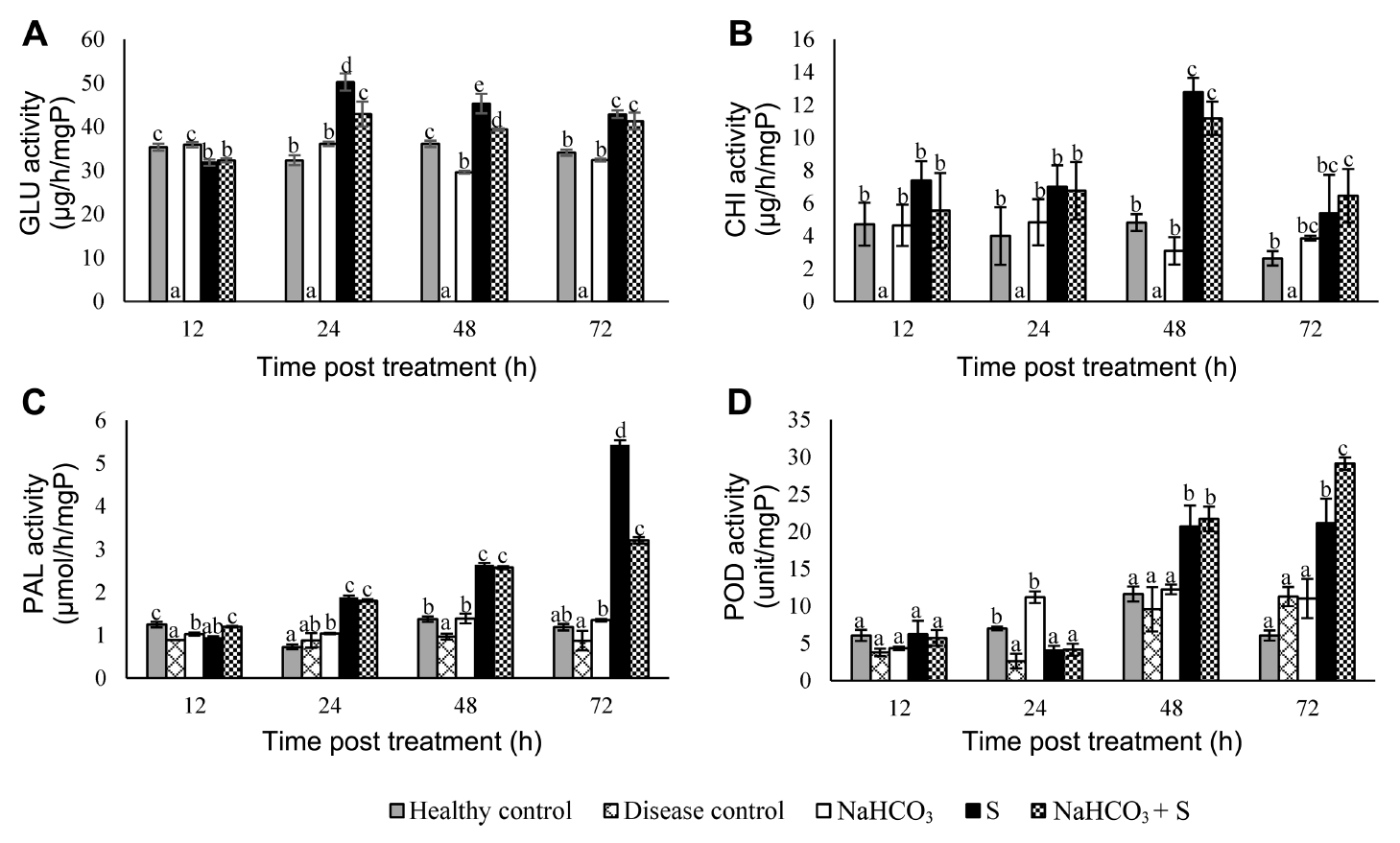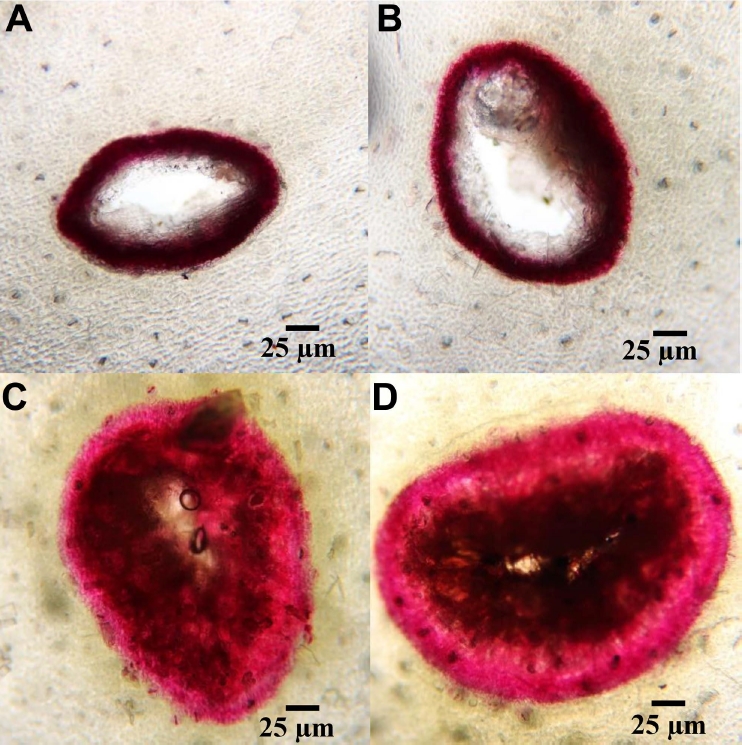Abeles, F. B. and Forrence, L. E. 1970. Temporal and hormonal control of β-1,3-glucanase in
Phaseolus vulgaris L.
Plant Physiol. 45:395-400.



Ali, A., Zahid, N., Manickam, S., Siddiqui, Y., Alderson, P. G. and Maqbool, M. 2014. Induction of lignin and pathogenesis related proteins in dragon fruit plants in response to submicron chitosan dispersions.
Crop Prot. 63:83-88.

Bradford, M. M. 1976. A rapid and sensitive method for the quantitation of microgram quantities of protein utilizing the principle of protein-dye binding.
Anal. Biochem. 72:248-254.


Chandrasekaran, M., Paramasivan, M. and Chun, S.-C. 2019.
Bacillus subtilis CBR05 induces vitamin B6 biosynthesis in tomato through the
de novo pathway in contributing disease resistance against
Xanthomonas campestris pv.
vesicatoria.
Sci. Rep. 9:6495.




Chuang, M. F., Ni, H. F., Yang, H. R., Shu, S. L., Lai, S. Y. and Jiang, Y. L. 2012. First report of stem canker disease of Pitaya (
Hylocereus undatus and
H. polyrhizus) caused by
Neoscytalidium dimidiatum in Taiwan.
Plant Dis. 96:906.

Ezra, D., Liarzi, O., Gat, T., Hershcovich, M. and Dudai, M. 2013. First report of internal black rot caused by
Neoscytalidium dimidiatum on
Hylocereus undatus (Pitahaya) fruit in Israel.
Plant Dis. 97:1513.

Ellis, M. B. 1971. Dematiaceous Hyphomycetes. Commonwealth Mycological Institute, Kew, UK. 608.
Farzaneh, M., Shi, Z.-Q., Ahmadzadeh, M., Hu, L.-B. and Ghassempour, A. 2016. Inhibition of the
Aspergillus flavus growth and aflatoxin B1 contamination on pistachio nut by fengycin and surfactin-producing
Bacillus subtilis UTBSP1.
Plant Pathol. J. 32:209-215.



Fiorin, G. L., Sanchéz-Vallet, A., de Toledo Thomazella, D. P., do Prado, P. F. V., do Nascimento, L. C., de Oliveira Figueira, A. V., Thomma, B. P. H. J., Pereira, G. A. G. and Teixeira, P. J. P. L. 2018. Suppression of plant immunity by fungal chitinase-like effectors.
Curr. Biol. 28:3023-3030.


Gamliel, A., Katan, J. and Cohen, E. 1989. Toxicity of chloronitrobenzenes to
Fusarium oxysporum and
Rhizoctonia solani as related to their structure.
Phytoparasitica. 17:101-106.

Hazarika, D. J., Goswami, G., Gautom, T., Parveen, A., Das, P., Barooah, M. and Boro, R. C. 2019. Lipopeptide mediated biocontrol activity of endophytic
Bacillus subtilis against fungal phytopathogens.
BMC Microbiol. 19:71.




Ippolito, A., Schena, L., Pentimone, I. and Nigro, F. 2005. Control of postharvest rots of sweet cherries by pre- and postharvest applications of
Aureobasidium pullulans in combination with calcium chloride or sodium bicarbonate.
Postharvest Biol. Technol. 36:245-252.

Jiwanit, P., Pitakpornpreecha, T., Pisuchpen, S. and Leelasuphakul, W. 2018. The use of
Aloe vera gel coating supplemented with
Pichia guilliermondii BCC5389 for enhancement of defense-related gene expression and secondary metabolism in mandarins to prevent postharvest losses from green mold rot.
Biol. Control. 117:43-51.

Lu, Z., Lu, X., Qin, B., Cheng, M., Huang, L., Chen, B. and Liao, Y. 2015. Identification of pathogen of pitaya stem canker disease in Fangchenggang city of Guangxi. J. South. Agric. 46:1606-1612.
Luong, H. T., Kieu, B. T. N., Vu, T. N., Ha, T. T., Van Tong, H., Hua, T. S., Nguyen, N. Q. and Nguyen, T. H. N. 2016. Study on the possibility of using microorganisms as biological agents to control fungal pathogens
Neoscytalidium dimidiatum causing disease of brown spots on the dragon fruit.
J. Viet. Environ. 8:41-44.

Marín, A., Atarés, L. and Chiralt, A. 2017. Improving function of biocontrol agents incorporated in antifungal fruit coatings: a review.
Biocontrol Sci. Technol. 27:1220-1241.

Masratul Hawa, M., Salleh, B. and Latiffah, Z. 2013. Characterization and pathogenicity of
Fusarium proliferatum causing stem rot of
Hylocereus polyrhizus in Malaysia.
Ann. Appl. Biol. 163:269-280.

Miller, G. L. 1959. Use of dinitrisalicylic acid reagent for determination of reducing sugars.
Anal. Chem. 31:426-428.

Munir, S., Li, Y., He, P., He, P., Ahmed, A., Wu, Y. and He, Y. 2020. Unraveling the metabolite signature of citrus showing defense response towards
Candidatus Liberibacter asiaticus after application of endophyte
Bacillus subtilis L1-21.
Microbiol. Res. 234:126425.


Sanahuja, G., Lopez, P. and Palmateer, A. J. 2016. First report of
Neoscytalidium dimidiatum causing stem and fruit canker of
Hylocereus undatus in Florida.
Plant Dis. 100:1499-1499.

Sandhu, J. S., Sidhu, M. K. and Yadav, I. S. 2017. Control of fungal diseases in agricultural crops by chitinase and glucanase transgenes. In: Sustainable agriculture reviews, eds. by E. Lichtfouse, 163-212. Springer, Cham, Switzerland.
Spadaro, D. and Droby, S. 2016. Development of biocontrol products for postharvest diseases of fruit: the importance of elucidating the mechanisms of action of yeast antagonists.
Trends Food Sci. Technol. 47:39-49.

Tuan, L. N. A., Du, B. D., Ha, L. D. T., Dzung, L. T. K., Phu, D. V. and Hien, N. Q. 2019. Induction of chitinase and brown spot disease tesistance by oligochitosan and nanosilica-oligochitosan in dragon fruit plants.
Agric. Res. 8:184-190.

Ullrich, C., Kluge, B., Palacz, Z. and Vater, J. 1991. Cell-free biosynthesis of surfactin, a cyclic lipopeptide produced by
Bacillus subtilis.
Biochemistry. 30:6503-6508.


Valencia-Botín, A. J., Sandoval-Islas, J. S., Cárdenas-Soriano, E., Michailides, T. J. and Rendón-Sánchez, G. 2003.
Botryosphaeria dothidea causing stem spots on
Hylocereus undatus in Mexico.
Plant Pathol. 52:803.

Vallet, C., Chabbert, B., Czaninski, Y. and Monties, B. 1996. Histochemistry of lignin deposition during sclerenchyma differentiation in alfalfa stems.
Ann. Bot. 78:625-632.

Waewthongrak, W., Leelasuphakul, W. and McCollum, G. 2014. Cyclic lipopeptides from
Bacillus subtilis ABS-S14 elicit defense-related gene expression in citrus fruit.
PLoS ONE. 9:e109386.



Waewthongrak, W., Pisuchpen, S. and Leelasuphakul, W. 2015. Effect of
Bacillus subtilis and chitosan applications on green mold (
Penicilium digitatum Sacc.) decay in citrus fruit.
Technol. 99:44-49.

Wingfield, P. T. 2016. Protein precipitation using ammonium sulfate.
Curr. Protoc. Protein Sci. 84:A.3F.1-A.3F.9.


Xu, M., Peng, Y., Qi, Z., Yan, Z., Yang, L., He, M.-D., Li, Q.-X., Liu, C.-L., Ruan, Y.-Z., Wei, S.-S., Xie, J., Xia, Y.-Q. and Tang, H. 2018. Identification of
Neoscytalidium dimidiatum causing canker disease of pitaya in Hainan, China.
Australas. Plant Pathol. 47:547-553.

Yi, R. H., Ling Lin, Q., Mo, J. J., Wu, F. F. and Chen, J. 2015. Fruit internal brown rot caused by
Neoscytalidium dimidiatum on pitahaya in Guangdong province, China.
Australas. Plant Dis. Notes. 10:13.


Youssef, K., Sanzani, S. M., Ligorio, A., Ippolito, A. and Terry, L. A. 2014. Sodium carbonate and bicarbonate treatments induce resistance to postharvest green mould on citrus fruit.
Postharvest Biol. Technol. 87:61-69.

Zahid, N., Ali, A., Manickam, S., Siddiqui, Y., Alderson, P. G. and Maqbool, M. 2014. Efficacy of curative applications of submicron chitosan dispersions on anthracnose intensity and vegetative growth of dragon fruit plants.
Crop Prot. 62:129-134.

Zhang, S., Zheng, Q., Xu, B. and Liu, J. 2019. Identification of the fungal pathogens of postharvest disease on peach fruits and the control mechanisms of
Bacillus subtilis JK-14.
Toxins. 11:322.














 PDF Links
PDF Links PubReader
PubReader ePub Link
ePub Link Full text via DOI
Full text via DOI Full text via PMC
Full text via PMC Download Citation
Download Citation Print
Print



